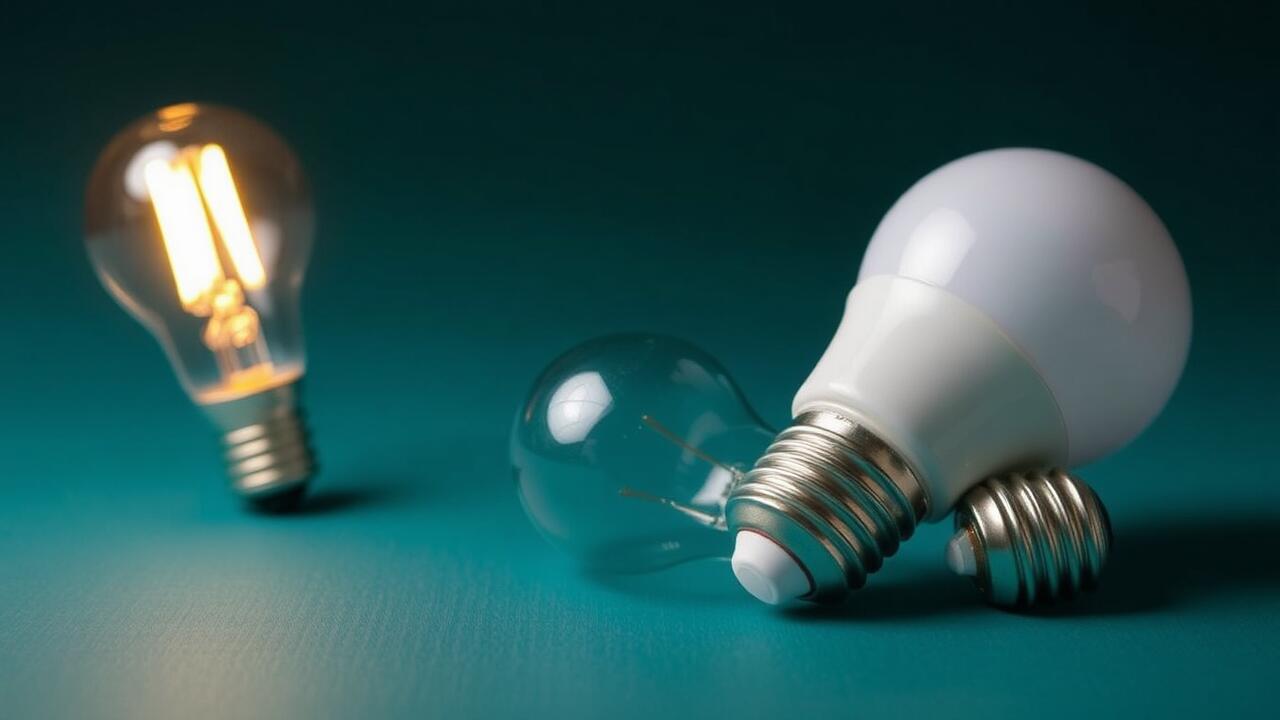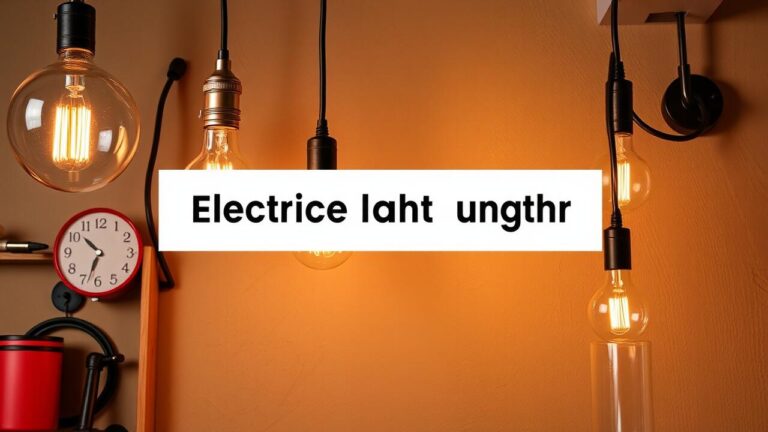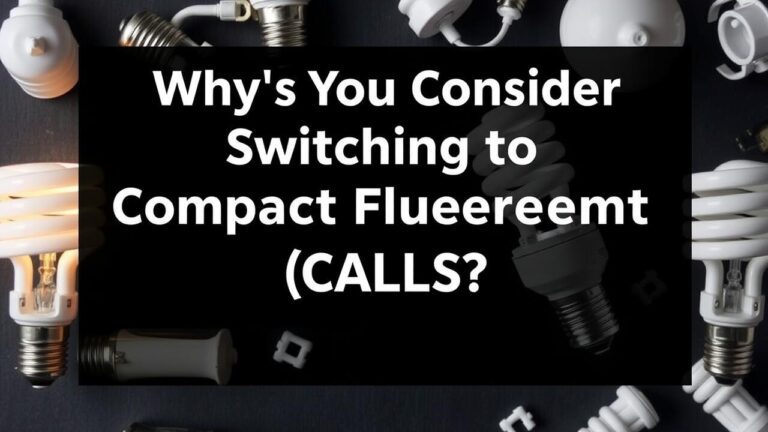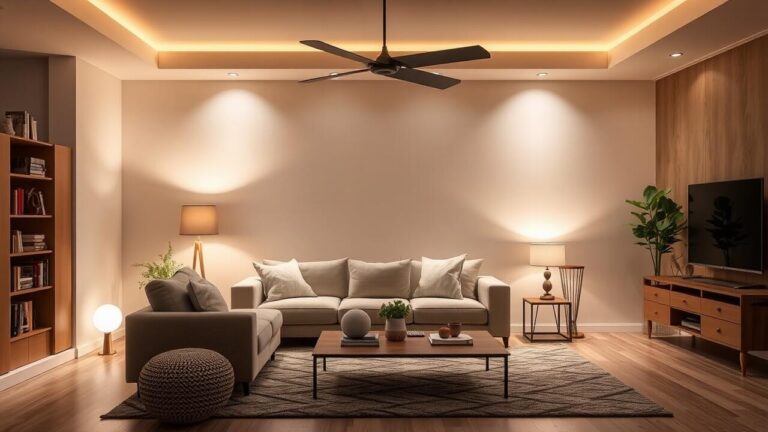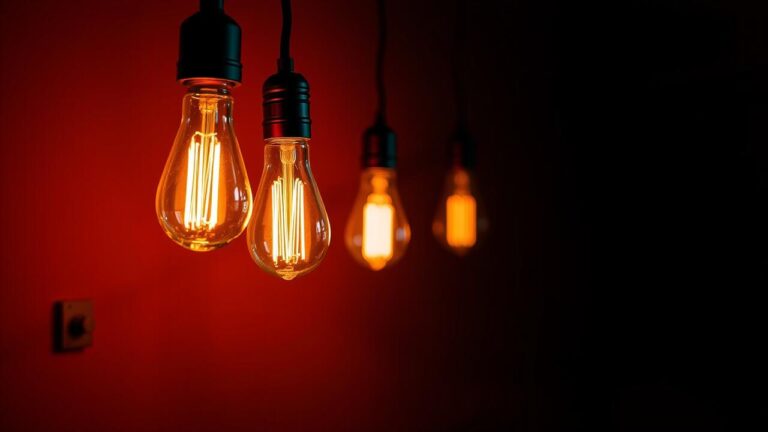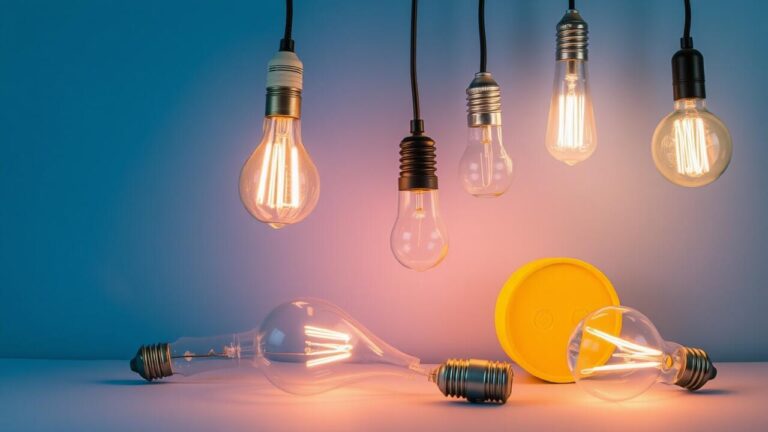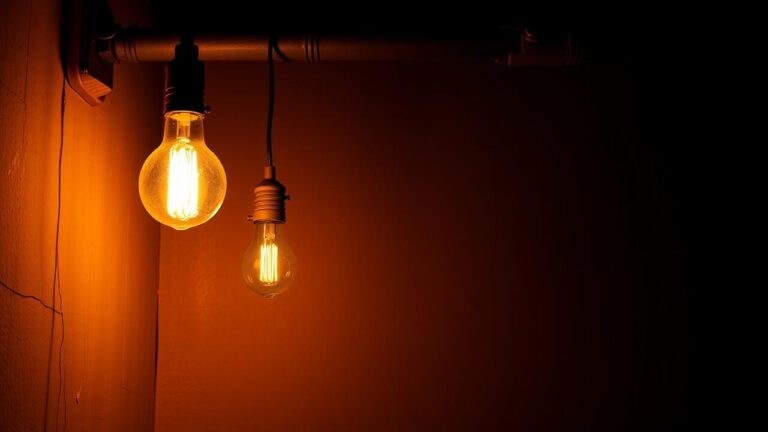What to Consider When Replacing Incandescent Bulbs with LED Bulbs
Table Of Contents
What to Consider When Replacing Incandescent Bulbs with LED Bulbs for Your Home
Key Takeaways
- Aspects to ponder when transitioning from traditional bulbs to energy-efficient alternatives, including advantages of the shift.
- Essential elements to evaluate when substituting conventional lighting sources.
- Suitability and setup considerations for energy-saving lighting options.
- Ecological effects of traditional versus modern lighting technologies.
- Frequently held beliefs regarding energy-efficient lighting solutions.
- Selecting the appropriate energy-efficient bulbs for individual requirements.
What To Consider When Replacing Incandescent Bulbs With LED Bulbs | Benefits of Switching from Incandescent Bulbs to LED Bulbs
The transition from incandescent bulbs to LED bulbs presents several factors to consider for a successful upgrade. Energy efficiency is one of the key benefits of switching from incandescent light bulbs to LED light bulbs, as LED bulbs consume significantly less power while providing the same, if not greater, brightness. This shift is crucial in reducing electricity bills and lowering carbon footprints. It is also essential to evaluate brightness levels measured in lumens rather than watts, ensuring that the LED bulbs chosen will meet the specific lighting needs of your space. Understanding the color temperature of light emitted by LED bulbs can drastically impact the ambiance of a room, making it vital to select the right type for your environment. By addressing these considerations, homeowners can make informed choices that enhance both their living spaces and energy efficiency.
| Factor | Incandescent Bulbs | LED Bulbs |
|---|---|---|
| Energy Efficiency | 10-17 lumens per watt | 80-100 lumens per watt |
| Average Lifespan | 1,000 hours | 15,000-50,000 hours |
| Heat Emission | High | Low |
| Color Temperature Options | 2700K (warm white) | 2200K – 6000K (various options) |
| Environmental Impact | Higher carbon footprint | Lower carbon footprint |
What to Consider When Replacing Incandescent Bulbs with LED Bulbs | Energy Efficiency of LED Light Bulbs
Energy efficiency is a key factor in the transition from incandescent bulbs to LED light bulbs. Incandescent lighting typically converts only about 10% of the energy it consumes into visible light, while the rest is lost as heat. In contrast, LED bulbs outperform conventional light bulbs by converting around 90% of their energy into light. This remarkable efficiency makes LED options ideal energy-saving light bulbs, reducing both electricity bills and overall energy consumption.
What to consider when replacing incandescent bulbs with LED bulbs also includes the lifespan of the products. Incandescents generally last about 1,000 hours, while LED bulbs can shine for up to 25,000 hours or more. This longevity not only means fewer replacements but also contributes to a significant decrease in waste over time. Transitioning to LEDs is not merely about immediate energy savings; it’s a long-term investment in more sustainable lighting solutions without sacrificing quality or brightness.
Cost Savings Over Time
Switching to LED lighting offers substantial cost savings over time, especially when compared to filament light bulbs and halogen light bulbs. The initial price of LED light bulbs can be higher, but their longevity and lower energy consumption quickly compensate for this expense. LED bulbs consume significantly less electricity, often using up to 80% less than conventional light bulbs. This reduction translates directly to lower energy bills, making it a financially savvy choice for households.
Beyond energy savings, LED strip lighting enhances efficiency in both residential and commercial spaces. These bulbs last up to 25,000 hours, far exceeding the lifespan of traditional light bulbs, which require frequent replacements. As a result, fewer trips to the store and less waste contribute to ongoing cost efficiency. Understanding what to consider when replacing incandescent bulbs with LED bulbs allows homeowners to realize these financial benefits more effectively.
Key Factors to Consider When Replacing Incandescent Light Bulbs
Transitioning from traditional incandescent bulbs to LED lights involves several key considerations. Energy-saving light bulbs, such as LED lights, provide significant advantages over halogen bulbs and fluorescent lighting, making them an attractive choice for many households. Understanding what to consider when replacing incandescent bulbs with LED bulbs includes evaluating brightness measured in lumens rather than watts, as well as the color temperature to set the desired ambiance. Selecting the right LED light ensures compatibility with existing fixtures and meets specific lighting needs. This shift not only enhances energy efficiency but also contributes to long-term cost savings, making LED bulbs a smart investment for any lighting upgrade.
Brightness: Lumens vs. Watts
Understanding the difference between lumens and watts is essential in the context of what to consider when replacing incandescent bulbs with LED bulbs. Lumens measure the brightness or illumination provided by a light source, while watts indicate the energy consumption of that light source. This distinction is especially important because LED bulbs provide more lumens per watt compared to traditional options like incandescent, halogen light bulbs, or fluorescent lamps. Therefore, choosing LED bulbs with the appropriate lumen rating can effectively enhance the brightness in your light fixtures without consuming excessive energy.
Selecting the right brightness for your needs also involves evaluating how your lamps will be used in various electrical installations. For instance, a higher lumen output may be desirable for task lighting in workspaces, while ambient lighting might require softer illumination. Understanding these factors will help you make informed decisions about the type of LED bulbs that best fit your specific requirements. This clarity will guide you through the considerations involved in what to consider when replacing incandescent bulbs with LED bulbs, ensuring optimal lighting for your environment.
Color Temperature and Its Impact on Ambiance
Understanding the color temperature of LED bulbs is essential for creating the desired atmosphere in a space. Different color temperatures can evoke various moods, ranging from warm whites that replicate the glow of incandescent bulbs to cooler, more energizing tones. This consideration is crucial for fixtures needing compatibility with existing light sockets, such as lamps that may traditionally use fluorescent or incandescent bulbs. Choosing the right temperature can enhance the ambiance while reducing electricity consumption.
Selecting the appropriate color temperature not only affects the look of a room but also impacts how much electricity is used in lighting. Warmer light temperatures often create a cozy atmosphere, ideal for living rooms and bedrooms. Cooler temperatures can be beneficial in workspaces where concentration is key. Evaluating these aspects is fundamental in the decision-making process, highlighting what to consider when replacing incandescent bulbs with LED bulbs. Understanding how light tubes and transformers work in relation to color temperature can further guide effective lighting choices.
- Consider the purpose of the room when selecting color temperature.
- Warmer temperatures (2700K-3000K) are best for relaxation and comfort.
- Cooler temperatures (4000K-5000K) are ideal for work environments and task-oriented spaces.
- Pay attention to how different colors of light can affect mood and productivity.
- Be mindful of the color rendering index (CRI) for more accurate color representation in a space.
- Don’t forget about dimmable options for added versatility in ambiance.
- Test different color temperatures in the actual space to see how light interacts with wall colors and furnishings.
Compatibility and Installation of LED Bulbs
Replacing incandescent bulbs with LED bulbs requires careful attention to compatibility and installation to ensure optimal performance. What to consider when replacing incandescent bulbs with LED bulbs includes checking whether your fixtures and dimmer switches are compatible with LED technology. Current incandescent bulbs contain filaments that operate differently than LED technology, which can affect how bulbs emit light. Traditional incandescent bulbs produce a warm glow, but LED bulbs come in a variety of color temperatures, allowing for customizable ambiance. Evaluating these factors can enhance your experience with LED lighting while maximizing energy efficiency and cost savings.
- Ensure that the wattage of the LED bulb matches the requirements of your fixture.
- Check if your dimmer switch is compatible with LED bulbs to avoid flickering or buzzing noises.
- Consider the color temperature of the LED bulb to achieve the desired ambiance in your space.
- Take note of the bulb shape and base type to ensure proper fit in your existing fixtures.
- Look for ENERGY STAR certified LED bulbs for enhanced energy efficiency and performance.
- Verify if any additional adapters or modifications are necessary for fixtures that are not inherently compatible.
- Always follow manufacturer guidelines for installation to ensure safety and optimal performance.
Dimmer Switch Compatibility
Compatibility with dimmer switches is a vital factor in the transition from traditional light bulbs to LED bulbs. Many households still rely on these conventional bulbs, which often work seamlessly with existing dimmers. However, not all LED bulbs are designed to be dimmable. Understanding what to consider when replacing incandescent bulbs with LED bulbs involves checking the specifications of both the dimmer switch and the bulbs room to ensure they function together effectively.
Some dimmer switches may require specific types of LED bulbs to achieve optimal performance, making it essential to select lasting bulbs that are compatible. A poorly matched setup can lead to flickering or reduced brightness, diminishing the overall experience. Evaluating the capabilities of your bulbs stand and ensuring they work harmoniously with your existing dimming system will enhance the ambiance of your space and maintain the energy efficiency that LED lighting promises.
Fixture and Socket Considerations
Selecting the right fixtures and sockets is crucial in the transition to energy-saving bulbs. Understanding the specifications of your existing fixtures can help ensure compatibility with the new LED options. Many common light bulb types, including screw-in bulbs and bi-pin light bulbs, have distinct requirements. It is essential to verify whether your fixtures allow halogen bulbs or have limitations that could affect your choice of LED products. Taking these factors into account is part of what to consider when replacing incandescent bulbs with LED bulbs.
The wattage and design of your current fixtures will impact the performance of your new energy-saving bulbs. LED bulbs emit light differently than incandescent options, which may require adjustments to fixture placement or orientation. OEM bulbs often have recommended guidelines that can help optimize your lighting experience. Ensuring that your chosen LED replacement fits properly within your existing hardware will enhance both the efficiency and ambiance of your space, highlighting the importance of fixture and socket compatibility in this transition.
Environmental Impact of Incandescent and LED Light Bulbs
Switching to LED lighting solutions provides a significant opportunity to reduce environmental impact. What to consider when replacing incandescent bulbs with LED bulbs includes their reduced energy consumption and longer lifespan, which minimizes waste. The frosted light bulb and edison-style LEDs are popular choices that can enhance aesthetics while offering efficiency. By opting for the right bulb, such as a single light bulb that uses less energy than an old bulb, consumers can contribute to lowering their carbon footprint. Understanding these factors makes it easier to make informed decisions about which products to select for both performance and environmental responsibility.
Reducing Carbon Footprint with LED Bulbs
Switching from incandescent bulbs to light-emitting diodes (LEDs) significantly reduces energy consumption, leading to a smaller carbon footprint. LED bulbs are known for their efficient lighting capabilities, using up to 80% less energy than traditional incandescent options. Whether you’re using daylight LEDs or LED light tubes, the impact on your overall lighting system is profound. Consulting with a lighting specialist can help you determine what to consider when replacing incandescent bulbs with LED bulbs to maximize energy efficiency and environmental benefits.
The longevity of LED bulbs also plays a vital role in reducing waste and emissions. Traditional incandescent bulbs typically last about 1,000 hours, while LEDs can last over 25,000 hours. This durability leads to fewer replacements and less frequent disposal of bulbs, which contributes to a decrease in environmental impact. Adjustable-brightness lights further enhance efficiency by allowing users to customize energy usage. Understanding these factors is essential for anyone looking to make informed decisions about their lighting systems.
Recycling Options for Conventional Light Bulbs
Proper disposal of conventional light bulbs is essential to minimize their environmental impact. Many incandescent bulbs may be thrown in the regular trash, but it is always best to check with local regulations since some areas have specific disposal guidelines. Many lighting experts recommend seeking out recycling programs that accept these bulbs. This approach ensures that materials are handled correctly, preserving valuable resources while reducing landfill waste. Exploring led alternatives can also enhance your efforts to reduce environmental damage, making the switch to LED technology not only a cost-effective move but also an eco-friendly one.
For households with ample lighting needs, understanding the different types of bulbs and their bases is crucial. Conventional bulbs can vary in bulb base types, which affects compatibility with fixtures and recycling options. GoodBulb LEDs provide efficient replacements for incandescent bulbs while promoting sustainable practices. Addressing lighting questions about the disposal and recycling of traditional bulbs helps consumers make informed decisions. Knowing what to consider when replacing incandescent bulbs with LED bulbs goes beyond efficiency; it involves a commitment to responsible energy use and waste management.
Common Misconceptions About LED Light Bulbs
Many people hold misconceptions about LED light bulbs that can impact their decision-making process. Understanding what to consider when replacing incandescent bulbs with LED bulbs includes recognizing the versatility of LEDs in various applications. The LED market has expanded significantly, providing options that offer brighter light with low energy consumption. Navigating illumination options involves knowing how to choose the right bulbs for general room lighting and outdoor lighting, ensuring the desired brightness is achieved efficiently. It’s also essential to note that LED bulbs come in various designs, including those compatible with different bulb socket connectors, allowing for easy integration into existing fixtures. The ability to provide diffused light without sacrificing performance makes LEDs a smart choice for anyone looking to upgrade their lighting solutions.
Initial Cost vs. LongTerm Value
Considering the initial cost of LED bulbs compared to traditional options is essential. What to Consider When Replacing Incandescent Bulbs with LED Bulbs often includes the fact that LED bulbs may have a higher upfront price tag. However, their longevity and energy efficiency can lead to substantial cost savings over time. For instance, using LED tubes and CFL ceiling lights can dramatically reduce electricity bills, which is a significant factor to weigh against the nostalgic glow of incandescent lights.
The long-term value derived from LED bulbs often offsets their initial expense. These modern fixtures, such as vanity lights and recessed lighting, emit less heat while providing the same brightness as incandescent bulbs. This efficiency translates into lower energy consumption and a decreased need for frequent replacements. Evaluating both the short-term costs and long-term benefits is crucial in making an informed decision about What to Consider When Replacing Incandescent Bulbs with LED Bulbs.
| Bulb Type | Initial Cost (per bulb) | Average Lifespan (hours) | Energy Consumption (watts) | Estimated Annual Cost (electricity) |
|---|---|---|---|---|
| Incandescent | $1.00 | 1,000 | 60 | $7.23 |
| CFL | $2.50 | 10,000 | 15 | $1.81 |
| LED | $3.00 | 25,000 | 10 | $1.21 |
| LED Tube | $5.00 | 30,000 | 15 | $1.81 |
Performance in Different Lighting Conditions
Understanding how LED bulbs perform in various lighting conditions is crucial for making informed decisions. What to Consider When Replacing Incandescent Bulbs with LED Bulbs includes evaluating specific scenarios where light quality matters. For instance, while a lamp model might be ideal for ambient lighting, you may need a brighter sink light for task-oriented spaces. Choosing the right color temperature, like white light, can also enhance visibility and comfort in challenging environments.
Some users fear that LED bulbs may not perform as well as incandescent or fluorescent lights in certain situations. This misconception can lead to hesitance in replacing existing bulbs. The truth is that many advanced LED options provide excellent illumination, catering to different needs, whether for reading, cooking, or relaxing. By understanding the performance characteristics of LEDs, consumers can better assess how these energy-efficient bulbs will affect their electricity bills while ensuring they meet their lighting needs.
Choosing the Right LED Bulbs for Your Needs
Selecting the right LED bulbs involves several key factors, particularly regarding the specifics outlined in What to Consider When Replacing Incandescent Bulbs with LED Bulbs. The first consideration should be power consumption; LEDs are significantly more efficient, providing a bright output with lower wattage. Various led variants available today cater to different needs, including options that focus on reducing blue light emissions. It’s essential to assess the color temperature, especially within the daylight range, as this can dramatically change the ambiance of your space. Pay close attention to the compatibility with your existing fixtures, as an incompatible bulb could lead to performance issues. Taking the time to research and understand these aspects will ensure that your transition to LED lighting is both effective and satisfying.
Conclusion
Switching from incandescent bulbs to LEDs requires careful consideration of various factors to ensure optimal results. Understanding what to consider when replacing incandescent bulbs with LED bulbs can help consumers navigate illumination options effectively. The energy efficiency and lifespan of LED bulbs contribute to significant cost savings and sustainability. It’s essential to evaluate desired brightness expressed in lumens rather than watts, particularly for general room lighting and outdoor lighting. Compatibility with existing fixtures and bulb socket connectors ensures a seamless transition, while considerations like color temperature and diffused light can enhance ambiance. Ultimately, embracing the LED market not only leads to brighter light but also aligns with eco-friendly practices.
FAQS
What are the benefits of switching from incandescent filament light bulbs to LED (light-emitting diode) bulbs in household bulbs?
Switching from incandescent filament light bulbs to LED (light-emitting diode) bulbs offers numerous benefits. Firstly, the light bulb emits more light while using significantly less energy, which can lead to reduced electricity bills. Additionally, LED area lights have a longer lifespan compared to traditional incandescent bulbs. When you replace the first bulb with a second bulb, you’ll notice that the LED bulb not only adapts better to different electricity systems but also emits less heat, making them safer for household use.
What should I know about using double-ended light bulbs as an alternative to traditional household bulbs?
When considering an alternative to traditional household bulbs, double-ended light bulbs can offer a variety of advantages, including improved energy efficiency and longer lifespan compared to incandescent bulbs.
What factors should I evaluate when transitioning from incandescent bulbs to LED bulbs in my home?
When transitioning from incandescent bulbs to LED bulbs, consider factors such as energy efficiency, lifespan, light quality, and cost-effectiveness. LED bulbs use significantly less energy compared to incandescent options, which leads to reduced electricity bills. Additionally, they have a longer lifespan, which means fewer replacements and less waste over time. It’s also important to assess the color temperature and brightness of the LED bulbs to ensure they meet your lighting needs and preferences.
How can I determine the best LED bulbs to replace my current incandescent bulbs?
To determine the best LED bulbs to replace your current incandescent bulbs, consider factors such as brightness (measured in lumens), color temperature (measured in Kelvin), energy efficiency, and compatibility with existing fixtures. Additionally, assess the lifespan and warranty of the LED bulbs to ensure optimal performance and durability.
What impact does replacing traditional incandescent bulbs with energy-efficient LED bulbs have on electricity consumption?
Replacing traditional incandescent bulbs with energy-efficient LED bulbs can significantly reduce electricity consumption. LED bulbs consume up to 75% less energy than incandescent bulbs, ensuring that you not only save on your electricity bill but also contribute to environmental sustainability by lowering your carbon footprint.

